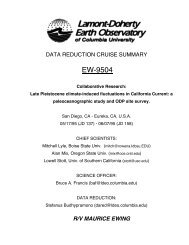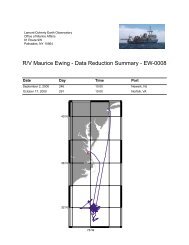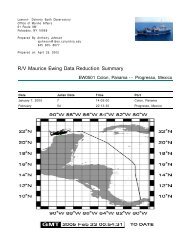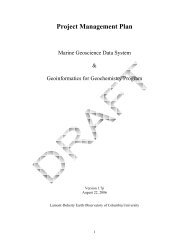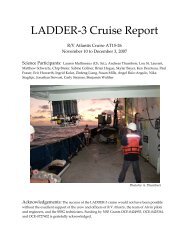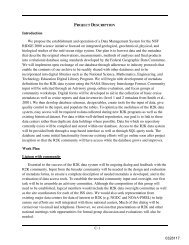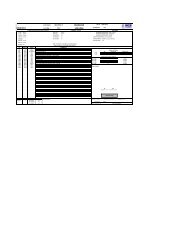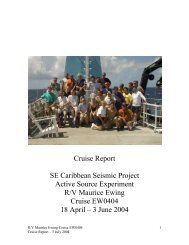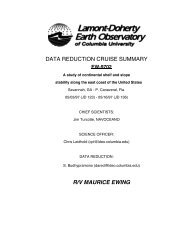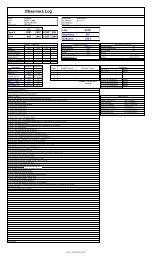NBP09-01 Cruise Report - British Oceanographic Data Centre
NBP09-01 Cruise Report - British Oceanographic Data Centre
NBP09-01 Cruise Report - British Oceanographic Data Centre
- No tags were found...
Create successful ePaper yourself
Turn your PDF publications into a flip-book with our unique Google optimized e-Paper software.
in the Amundsen Sea - (1) the confinement of drift ice by the Thwaites iceberg tongue, and (2) the importof thick multiyear ice from north of Thurston Island. The Thurston Island region is particularly interestingas it is a highly persistent region of perennial ice that appears to be maintained by a combination of highsnowfall and an unusually stable water column. Recent changes in ice extent and duration there may alsohave implications for the ice cover downstream in the Amundsen Sea.Generally, the underway sea ice observations qualitatively reflect the regional differences mentioned above.For example, average level (and ridged) sea ice thickness on our north-south transit (from the ice-coveredouter continental shelf south to open water in Pine Island Bay, Jan 12 to Jan 16), was 182 (and 253) cm.Average level (ridged) sea ice thickness on the subsequent northward but more westward transit (from thefast ice in Crosson Bay back to the outer continental shelf, Feb 5 to Feb 9), was 172 (246) cm. Continuingfurther west along the outer shelf (Feb 10 to Feb 15), average level (ridged) sea ice thickness was 141 (2<strong>01</strong>)cm. Thicker and more heavily ridged sea ice to the east is consistent with the probable import of multiyearice from the Thurston Island region, while thinner, less deformed sea ice further to the west (110-120W)indicated a predominance of local sea ice production.Preliminary analysis of samples taken suggests that the properties of Amundsen summer sea ice may havemore in common with previous observations in the Ross Sea than the Bellingshausen. Superimposed ice fromsnowmelt formed a relatively thin layer on most floes, and seawater flooding of the surface was observed atmost sites. Well-defined surface gap layers - important sea ice habitats - have been relatively infrequent.This is likely due to the high degree of deformation and surface flooding observed. Overall, this appears tobe consistent with a predominantly first-year summer sea ice cover.Snow depth averaged 47 cm. On the southward transect into Pine Island Bay the snow was warm andmelting, but by the time the pack ice was re-entered temperatures had cooled and the snow had begun tofreeze. Snow was predominantly icy and fresh even close to the slush/ice surface, suggesting there had beenat least moderate snow melt. However, snow crystal structure and the lack of thick layers of superimposedice suggest surface melt may have been modest. Average snow density was 400 kg m 3 .The flooding observed at most sites resulted in up to 39 cm of slush on top of the ice. In those cases wherethere was significant positive freeboard a thin layer of superimposed ice, formed from snowmelt, was present.In many cases, the location of the ice surface was unclear as the surface ice beneath the slush was often softand poorly consolidated. A thin ( 5 cm) layer of ice was often found “perched” above the slush layer similarto previous observations in the Ross Sea in summer. This was either superimposed ice or snow ice. AsFigure 26: Examples of thin and thick sections illustrating key processes. (A) Thin section of the upper partof an ice core above a gap layer from ice station 6. The very fine-grained granular structure (< 1mm) is likelysnow ice. (B) Thick section of a consolidated gap layer showing horizontal bands of bubbles. This suggeststhat the gap layer is snow ice. (C) Bottom section of a core from station 17 with platelet-like structureembedded in frazil and congelation layers. This is likely a refrozen void suggesting the ice was multiyear.(D) Thin section of buried superimposed ice formed from snowmelt from a multiyear ice core. (Photos byTed Maksym.)<strong>NBP09</strong>-<strong>01</strong> <strong>Cruise</strong> <strong>Report</strong> (p. 35 of 83) Revised February 27, 2009



